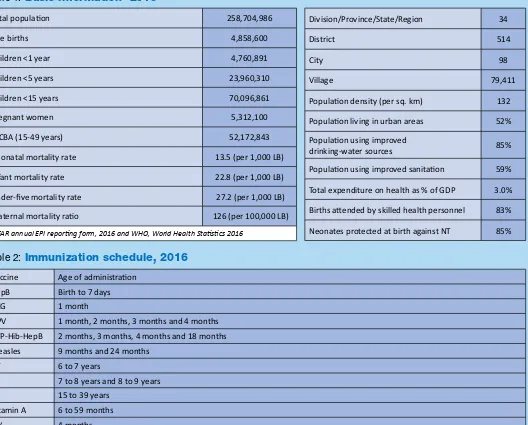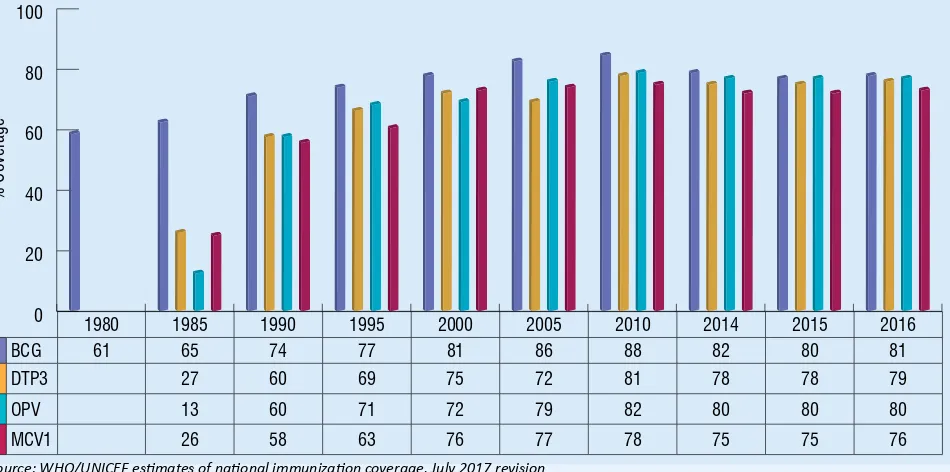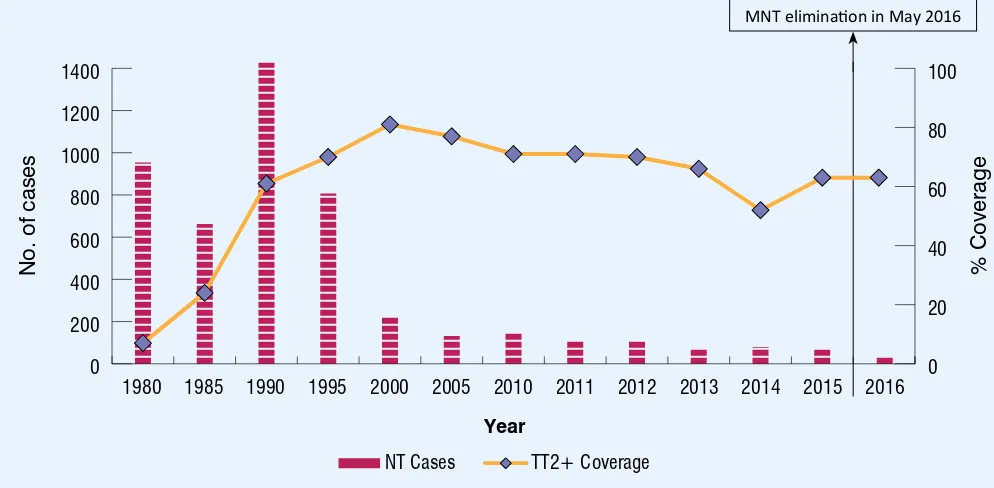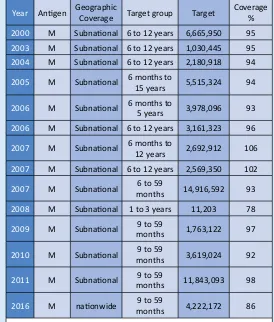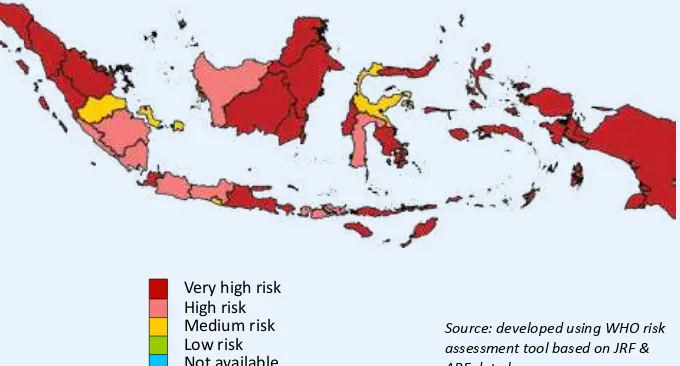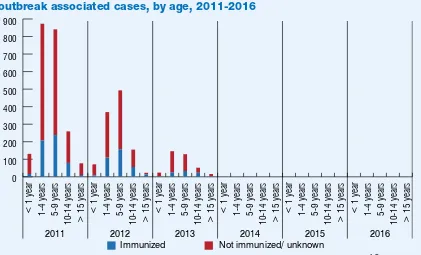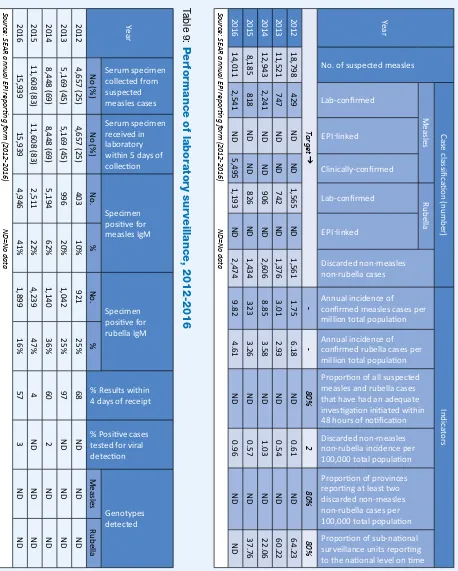Indonesia 2017
Acronyms
AD Auto disable
AEFI Adverse events following immunization
AFP Acute flaccid paralysis
BCG Bacillus Calmette-Guérin vaccine
CES Coverage evaluation survey
cMYP Comprehensive multi-year plan
CRS Congenital rubella syndrome
DHS Demographic health survey
DT Diphtheria tetanus toxoid, pediatric
DTP Diphtheria – tetanus – pertussis vaccine
DTP-Hib-HepB Pentavalent vaccine
DTP-Hib-HepB3 3rd dose pentavalent vaccine
EPI Expanded programme on immunization
GDP Gross domestic product
HCW Health care worker
HepB Hepatitis B vaccine
Hib Haemophilus influenzae type b
HPV Human papilloma virus
IgM Immunoglobulin M
IPV Inactivated poliovirus vaccine
JE Japanese encephalitis
JE_Live-Atd JE live attenuated vaccine
JRF WHO UNICEF joint reporting form
LB Live birth
M Measles
MCV1 First dose measles containing vaccine
MCV2 Second dose measles containing vaccine
MICS Multiple indicator cluster survey
MMR Measles mumps rubella vaccine
MNT Maternal and neonatal tetanus
MR Measles rubella vaccine
NCIP National committee on immunization practices
NID National immunization day
NTAGI National technical advisory group on immunization
NPEV Non-polio enterovirus
NT Neonatal tetanus
OPV Oral poliovirus vaccine
bOPV Bivalent OPV
tOPV Trivalent OPV
PCV Pneumococcal conjugate vaccine
SEAR WHO South-East Asia Region
SIA Supplementary immunization activities
SNID Subnational immunization day
Td Tetanus diphtheria toxoid; older children, adults
TT Tetanus toxoid
TT2+ 2 or more doses TT
VDPV Vaccine derived poliovirus
VPD Vaccine preventable diseases
WCBA Women of child bearing age
Contents
Impact of rouine immunizaion
Page
No.
EPI history 5
Basic informaion 2016 Table 1 5
Immunizaion schedule 2016 Table 2 5
Naional immunizaion coverage 1980 - 2016 Figure 1 6
Immunizaion system highlights Table 3 6
DTP3 coverage, diphtheria and pertussis cases 1980 - 2016 Figure 2 7 Reported cases of vaccine preventable diseases 2011 - 2016 Table 4 7
DTP-Hib-HepB3 coverage by province 2015 Figure 3 7
DTP-Hib-HepB3 coverage by province 2016 Figure 4 7
Towards measles eliminaion and rubella/congenital rubella
syndrome control
Page
No.
MCV1 and MCV2 coverage, measles and rubella cases, 1980-2016 Figure 11 11
MCV supplementary immunizaion aciviies Table 7 11
MCV1 coverage by province 2015 Figure 12 12
MCV1 coverage by province 2016 Figure 13 12
MCV2 coverage by province 2015 Figure 14 12
MCV1 coverage by province 2016 Figure 15 12
Immunity against measles – immunity proile by age in 2016 Figure 16 12 Subnaional risk assessment for measles and rubella Figure 17 12 Sporadic and outbreak associated measles cases by month 2011 - 2016 Figure 18 13 Immunizaion status of conirmed (laboratory and EPI linked) measles outbreak
associated cases by age 2011 – 2016 Figure 19 13
Quality of ield and laboratory surveillance for measles and rubella 2012 - 2016 Table 8 14
Performance of laboratory surveillance 2012 - 2016 Table 9 14
WHO supported laboratory network for VPD surveillance Figure 20 15
Maternal and neonatal tetanus eliminaion is sustained
Page
No.
TT2+ coverage and NT cases 1980 - 2016 Figure 5 8
Polio-free status is maintained
Page
No.
AFP surveillance indicators 2011 - 2016 Table 5 9
Non-polio AFP rate by province 2015 Figure 6 9
Non-polio AFP rate by province 2016 Figure 7 9
Environmental surveillance sites for polio detecion Figure 8 10 Adequate stool specimen collecion percentage by province 2015 Figure 9 10 Adequate stool specimen collecion percentage by province 2016 Figure 10 10
Indonesia: province level map
WHO South-East Asia Region
EPI history
• EPI launched in 1977
• HepB vaccine introduced in 1997
• AD syringe introduced in 2002
• MCV2 introduced in 2004
• DTP-HepB vaccine introduced in 2004 (in phases)
• IPV introduced in one province in 2007
• Pentavalent vaccine introduced in four provinces in 2013 and expanded to all provinces by 2014
• tOPV to bOPV switched on 04 April 2016
• IPV vaccine launched in naional rouine immunizaion programme from July 2016.
Source: cMYP 2015-2019 and EPI/MOH
Table 1:
Basic information
12016
Total populaion 258,704,986
Live births 4,858,600
Children <1 year 4,760,891
Children <5 years 23,960,310
Children <15 years 70,096,861
Pregnant women 5,312,100
WCBA (15-49 years) 52,172,843
Neonatal mortality rate 13.5 (per 1,000 LB)
Infant mortality rate 22.8 (per 1,000 LB)
Under-ive mortality rate 27.2 (per 1,000 LB)
Maternal mortality raio 126 (per 100,000 LB)
1SEAR annual EPI reporing form, 2016 and WHO, World Health Staisics 2016
Division/Province/State/Region 34
District 514
City 98
Village 79,411
Populaion density (per sq. km) 132 Populaion living in urban areas 52% Populaion using improved
drinking-water sources 85%
Populaion using improved sanitaion 59% Total expenditure on health as % of GDP 3.0% Births atended by skilled health personnel 83% Neonates protected at birth against NT 85%
Table 2:
Immunization schedule, 2016
Vaccine Age of administraion HepB Birth to 7 days
BCG 1 month
OPV 1 month, 2 months, 3 months and 4 months DTP-Hib-HepB 2 months, 3 months, 4 months and 18 months Measles 9 months and 24 months
DT 6 to 7 years
Td 7 to 8 years and 8 to 9 years
TT 15 to 39 years
Vitamin A 6 to 59 months
IPV 4 months
Source: WHO/UNICEF JRF, 2016
Table 3:
Immunization system highlights
cMYP for immunizaion 2015-2019
NTAGI fully funcional
Spending on vaccines inanced by the government 90%
Spending on rouine immunizaion programme inanced by the government 88%
Updated micro-plans that include aciviies to improve immunizaion coverage no data Naional policy for health care waste management including waste from immunizaion aciviies in place
Naional system to monitor AEFI in place
Most recent EPI CES Basic Health Survey 2013, District Coverage
Survey in 10 provinces and 31 districts 2015
>80% coverage for DTP-Hib-HepB3 375 districts (73%)
>90% coverage for MCV1 263 districts (51%)
>10% drop-out rate for DTP-Hib-HepB1 to DTP-Hib-HepB3 55 districts (11%)
Assessment of vaccine hesitancy at naional level 2013
Source: WHO/UNICEF JRF, 2016
Source: WHO/UNICEF esimates of naional immunizaion coverage, July 2017 revision
Figure 1:
National immunization coverage, 1980-2016
% Coverage
1980 1985 1990 1995 2000 2005 2010 2014 2015 2016
BCG 61 65 74 77 81 86 88 82 80 81
DTP3 27 60 69 75 72 81 78 78 79
OPV 13 60 71 72 79 82 80 80 80
MCV1 26 58 63 76 77 78 75 75 76
<70% 70% - 79% 80% - 89% >90%
Figure 3:
2015
Figure 4:
2016
Source: SEAR annual EPI reporing form, 2015 (administraive data)
Source: SEAR annual EPI reporing form, 2016 (administraive data)
Figure 2:
DTP3 coverage
1, diphtheria and pertussis cases
2, 1980-2016
Year
Diphtheria Cases Pertussis Cases DTP3 Coverage
%
1WHO/UNICEF esimates of naional immunizaion coverage, July 2017 revision 2WHO vaccine-preventable diseases: monitoring system 2016
Table 4:
Reported cases of vaccine preventable diseases, 2011-2016
Year Polio Diphtheria Pertussis (% of all Tetanus)NT Measles Rubella Mumps JE CRS
2011 0 806 1,941 114 (54%) 21,893 1,959 ND ND ND
Source: WHO/UNICEF JRF (muliple years) ND=No data
1980 1985 1990 1995 2000 2005 2010 2011 2012 2013 2014 2015 2016
NT Cases TT2+ Coverage 0
1WHO/UNICEF JRF, Country oicial esimates, 1980-2016 2WHO vaccine-preventable diseases: monitoring system 2016
Maternal and neonatal tetanus elimination is sustained
MNT eliminaion in May 2016
© WHO/Indonesia
Table 5:
AFP surveillance performance indicators, 2011-2016
Indicator 2011 2012 2013 2014 2015 2016
AFP cases 1,720 1,951 1,963 1,765 1,428 1,398
Wild poliovirus conirmed cases 0 0 0 0 0 0
Compaible cases 0 0 0 0 0 0
Non-polio AFP rate1 2.75 2.76 2.74 2.43 2.04 1.89
Adequate stool specimen collecion percentage2 91% 92% 88% 89% 92% 87%
Total stool samples collected 3,386 3,828 3,826 3,424 2,801 2,683
% NPEV isolaion 9 9 9 7 7 7
% Timeliness of primary result reported3 99 99 99 98 99 97
1Number of discarded AFP cases per 100,000 children under 15 years of age.
2Percent with 2 specimens, at least 24 hours apart and within 14 days of paralysis onset. 3Results reported within 14 days of sample received at laboratory.
Figure 6:
2015
Figure 7:
2016
Polio-free status is maintained
The last polio case due to WPV was reported from Tenggara district, Aceh on 20 February 2006.
Non-polio AFP rate by province
<1 1 – 1.99
>2 No non-polio AFP case
Figure 8:
Environmental surveillance sites for poliovirus detection
Figure 10:
2016
Figure 9:
2015
Table 6:
OPV SIAs
Year Anigen Geographic
coverage Target age
Target populaion Coverage (%)
Round 1 Round 2 Round 1 Round 2
2002 OPV NID <5 years 20,031,168 107 109
2005 OPV NID <5 years 23,426,156 95 98
2005 OPV NID <5 years 23,620,427 98
2006 OPV NID <5 years 23,620,427 99 100
2006 OPV SNID <5 years 4,523,187 6,045,438 97 92
2007 OPV SNID <5 years 12,517,699 90 92
2009 OPV SNID* <5 years 2,052,067 97
2010 OPV SNID* <5 years 4,322,178 92
2011 OPV SNID* <5 years 13,958,095 98
2016 OPV NID <5 years 23,721,004 22,883,910 96
* During measles campaign Source: WHO/UNICEF JRF (muliple years)
Adequate stool specimen collection % by province
<60% 60% - 79% >80% No AFP Yogyakarta - 1 site
Jakarta - 1 site West Java - 1 site
Towards measles elimination and rubella/CRS control
Figure 11:
MCV1 and MCV2 coverage
1, measles and rubella cases
2, 1980-2016
Measles Cases Rubella MCV1 Coverage MCV2 Coverage
2016
No. of cases
Year
1WHO/UNICEF esimates of naional immunizaion coverage, July 2017 revision 2WHO vaccine-preventable diseases: monitoring system 2016
Table 7:
MCV SIAs
Year Anigen Geographic
Coverage Target group Target
Coverage %
2000 M Subnaional 6 to 12 years 6,665,950 95
2003 M Subnaional 6 to 12 years 1,030,445 95
2004 M Subnaional 6 to 12 years 2,180,918 94
2005 M Subnaional 6 months to 15 years 5,515,324 94
2006 M Subnaional 6 months to
5 years 3,978,096 93
2006 M Subnaional 6 to 12 years 3,161,323 96
2007 M Subnaional 6 months to
12 years 2,692,912 106
2007 M Subnaional 6 to 12 years 2,569,350 102
2007 M Subnaional 6 to 59
months 14,916,592 93
2008 M Subnaional 1 to 3 years 11,203 78
2009 M Subnaional 9 to 59
months 1,763,122 97
2010 M Subnaional 9 to 59
months 3,619,024 92
2011 M Subnaional 9 to 59
months 11,843,093 98
2016 M naionwide 9 to 59
0%
Percent of population
Age (in years)
Protected by maternal antibodies Protected by routine vaccination with 1st dose
Protected by routine vaccination with 2nd dose Protected by SIAs
Immune due to past infection Susceptible
Figure 16:
Immunity against measles - immunity profile by age in 2016*
* Modeled using MSP tool ver 2 assuming the schedule and MCV coverage remain unchanged and Measles SIAs in 180 high risk districts in 2016.
<80% 80% - 89% 90% - 94% >95%
Figure 13:
2016
Figure 14:
2015
Figure 15 :
2016
Source: SEAR annual EPI reporing form, 2016 (administraive data)
Source: SEAR annual EPI reporing form, 2016 (administraive data)
Figure 12:
2015
Source: SEAR annual EPI reporing form, 2015 (administraive data)
Source: SEAR annual EPI reporing form, 2015 (administraive data)
Figure 17:
Sub-national risk assessment - measles and rubella
MCV1 coverage by province
MCV2 coverage by province
Source: developed using WHO risk assessment tool based on JRF & ARF data base
Figure 18:
Sporadic and outbreak associated measles cases* by month and 2011-2016
Outbreak associated measles
No of cases
0
*Includes laboratory conirmed and epidemiologically linked cases Source: SEAR Monthly VPD reports
Figure 19:
Immunization status of confirmed (laboratory and EPI linked) measles
outbreak associated cases, by age, 2011-2016
> 15 years
10-14 years
5-9 years
1-4 years
< 1 year
> 15 years
10-14 years
5-9 years
1-4 years
< 1 year
> 15 years
10-14 years
5-9 years
1-4 years
< 1 year
> 15 years
10-14 years
5-9 years
1-4 years
< 1 year
> 15 years
10-14 years
5-9 years
1-4 years
< 1 year
> 15 years
10-14 years
5-9 years
1-4 years
< 1 year
2011 2012 2013 2014 2015 2016
Immunized Not immunized/ unknown
Table 8:
Surveillance performance indicators for measles and rubella, 2012-2016
Year
No. of suspected measles
Case classiic
Discarded non-measles non-rubella cases
Annual incidence of conirmed measles cases per million total populaion
Annual incidence of conirmed rubella cases per million total populaion Proporion of all suspected measles and rubella cases that have had an adequate invesigaion iniiated within 48 hours of noiicaion
Discarded non-measles non-rubella incidence per 100,000 total populaion Proporion of provinces reporing at least two discarded non-measles non-rubella cases per 100,000 total populaion Proporion of sub-naional surveillance units reporing to the naional level on ime Lab-conirmed
AR annual EPI reporing f
orm (2012-2016)
ND=No dat
a
Year
Serum specimen collected from suspected measles cases
Serum specimen received in laboratory within 5 days of collecion
Specimen posiive for measles IgM
Specimen posiive for rubella IgM
% Results within 4 days of receipt
% Posiive cases tested for viral detecion
AR annual EPI reporing f
orm (2012-2016)
ND=No dat
a
Table 9:
Performance of laboratory surveillance, 2012-2016
Figure 20:
WHO supported laboratory network for VPD surveillance
Polio, measles & rubella laboratories • Naional Insitute of Health Research
and Development (NIHRD), Jakarta • Biofarma, Bandung
• Public Health Laboratory, Surabaya
Japanese encephaliis laboratories • NIHRD, Jakarta
• Public Health Laboratory, Denpasar
Measles & rubella laboratories • Public Health Laboratory, Yogyakarta • Public Health Laboratory, Palembang • Public Health Laboratory, Makassar • Public Health Laboratory, Jakarta
For contact or feedback:
Expanded Programme on Immunizaion
Ministry of Health, Jakarta, Indonesia
Tel : +62 21 4249024, Fax: +62 21 4249024 Email: primayosephine@yahoo.com www.depkes.go.id
Immunizaion and Vaccine Development (IVD)
WHO-SEARO, IP Estate, MG Marg, New Delhi 110002, India Tel: +91 11 23370804, Fax: +91 11 23370251
Email: SearEpidata@who.int
